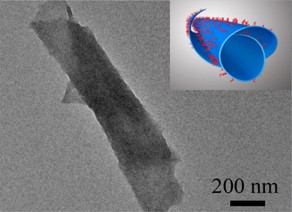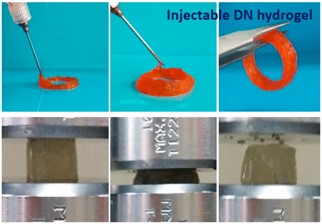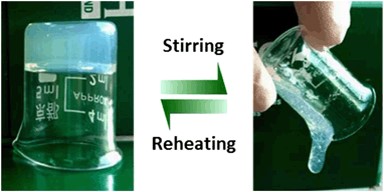1. Chen, Dong; Amstad, Esther; Zhao, Chungxia; Cai, Liheng; Fan, Jing; Chen, Qiushui; Hai, Mingtan; Koehler, Stephan; Zhang, Huidan*; Liang, Fuxin; Yang, Zhenzhong; Weitz, David A*. Biocompatible Amphiphilic Hydrogel–Solid Dimer Particles as Colloidal Surfactants, ACS Nano, 2017, 11(12): 11978-11985.
Emulsions of two immiscible liquids can slowly coalesce over time when stabilized by surfactant molecules. Pickering emulsions stabilized by colloidal particles can be much more stable. Here, we fabricate biocompatible amphiphilic dimerparticles using a hydrogel, a strongly hydrophilic material, and achieve large contrast in the wetting properties of the two bulbs, resulting in enhanced stabilization of emulsions. We generate monodisperse single emulsions of alginate and shellac solution in oil using a flow-focusing microfluidics device. Shellac precipitates from water and forms a solid bulb at the periphery of the droplet when the emulsion is exposed to acid. Molecular interactions result in amphiphilic dimer particles that consist of two joined bulbs: on ehydrogel bulb of alginate in water and the other hydrophobic bulb of shellac. Alginate in the hydrogel compartment can be cross-linked using calcium cations to obtain stable particles. Analogous to surfactant molecules at the interface,the resultant amphiphilic particles stand at the water/oil interface with the hydrogel bulb submerged in water and the hydrophobic bulb in oil and are thus able to stabilize both water-in-oil and oil-in-water emulsions, making theseamphiphilic hydrogel–solid particles ideal colloidal surfactants for various applications.

https://doi.org/10.1021/acsnano.7b03110
2. Liu, Yijiang; Xu, Jinyu; Liang, Fuxin; Yang, Zhenzhong*. Polymeric Janus Nanosheets by Template RAFT Polymerization, Macromolecules, 2017, 50(22): 9042-9047.
We report a general method to synthesize polymeric Janus nanosheets (PJS) by sequential RAFT grafting from a template particle surface. Layer number and composition of the PJS are tunable by feeding sequence and type of monomers.The cPNIPAM–PS PJS is flexible and thermal responsive, which can form a scrolled superstructure. A dually responsive cPAA–PNIPAM PJS is derived by hydrolysis of cPtBA–PNIPAM. Accordingly, stability of the emulsion with the cPAA–PNIPAM PJS is triggered by alternation of pH or/and temperature.

DOI:10.1021/acs.macromol.7b01558
https://pubs.acs.org/doi/10.1021/acs.macromol.7b01558
3. Yan, Yan; Li, Mengnan; Yang, Di; Wang, Qian; Liang, Fuxin; Qu, Xiaozhong*, Qiu, Dong; Yang, Zhenzhong*. Construction of Injectable Double-network Hydrogels for Cell Delivery, Biomacromolecules, 2017, 18(7), 2128-2138.
Herein we present a unique method of using dynamic cross-links, which are dynamic covalent bonding and ionic interaction, for the construction of injectable double-network (DN)hydrogels, with the objective of cell delivery for cartilage repair. Glycolchitosan and dibenzaldhyde capped poly(ethylene oxide) formed the first network,while calcium alginate formed the second one, and in the resultant DN hydrogel,either of the networks could be selectively removed. The moduli of the DN hydrogel were significantly improved compared to that of the parent single-network hydrogels and were tunable by changing the chemical components.In situ 3D cell encapsulation could be easily performed by mixing cell suspension to the polymer solutions and transferred through a syringe needle before sol–gel transition. Cell proliferation and mediated differentiation of mouse chondrogenic cells were achieved in the DN hydrogel extracellular matrix.

DOI: 10.1021/acs.biomac.7b00452
https://pubs.acs.org/doi/full/10.1021/acs.biomac.7b00452
4. Wu, Yuanyuan; Luo, Zhang; Liu, Bing*; Yang Zhenzhong. Colloidal Rings by Site-selective Growth on Patchy Colloidal Disc Templates, Angew. Chem. Int. Ed., 2017, 56(33): 9807-9811.
Anisotropic colloidal building blocks are quite attractive as they enable the self-assembly towards new materials with designated hierarchical structures. Although many advances have been achieved in colloidal synthetic methodology, synthesis of colloidal rings with low polydispersity and on a large scale remains a challenge. To address this issue we introduce a new site-selective growth strategy, which relies on using patchy particles. For example, by using patchy discs as templates, silica can selectively be grown on only side surfaces, resulting in formation of silica rings. We demonstrate that shape parameters are tunable and find that these silica rings can be used as secondary template to synthesize other types of rings.This method for synthesizing ring-likecolloids provides possibilities for studying their self‐assembly and associated phase transitions, and this patchy particles template strategy paves a new route for fabricating other new colloidal particles.

DOI:10.1002/anie.201704541
https://onlinelibrary.wiley.com/doi/full/10.1002/anie.201704541
5. Tang, Lin; Liang, Fuxin; Wang, Qiang; Qu, Xiaozhong; Jiang, Bingyin; Yang, Zhenzhong*. Polymer/metal segmental Janus nanoparticles, Chinese J. Polym. Sci., 2017, 35: 799-808.
Polymer/metal composite segmental Janus nanoparticles (NPs) are synthesized by sequential growth against poly(4-vinylpyridine) (P4VP) cross-linked cP4VP-PS Janus NPs. A Janus cluster ofpoly(4-vinylpyridine)-block-polystyrene (P4VP-b-PS) diblock copolymer is self-organized after absorption onto a silica patchy sphere via hydrogen bonding. Selective cross-linking of P4VP leads to the formation of robustcP4VP-PS Janus NPs. Within the cP4VP domain, functional species such as metalsare preferentially grown by in situ reduction. Other thiol-capped polymers, for example, thiol-capped poly(N-isopropylacrylamide)(PNIPAM-SH), can be conjugated onto the opposite side to form polymer/metal triple segmental Janus NPs. The hyperthermia effect of Au NP of PNIPAM-Au@cP4VP-PS by near infrared (NIR) irradiation can trigger a fast transition from amphiphilic to hydrophobic of the Janus NPs at low surrounding temperature. De-stabilization of the emulsion is NIR triggered although the system temperature is below LCST (~32 °C).

DOI:10.1007/s10118-017-1946-1
https://link.springer.com/article/10.1007%2Fs10118-017-1946-1
6. Zhu, Feiyan; Wang, Chen; Yang, Saina; Wang, Qian; Liang, Fuxin; Liu, Chenyang; Qiu, Dong*; Qu, Xiaozhong*; Hu, Zhongbo; Yang, Zhenzhong*. Injectabletissue Adhesive Composite Hydrogel with Fibroblasts for Treating Skin Defects, J. Mater. Chem. B, 2017, 5(13): 2416-2424.
In this work, an injectable composite hydrogel was synthesized via a unique way of cross-linking glycol chitosan(GC) with silica nano-particles (SiNP) through non-chemical interactions, andwas then applied as a kind of wound dressing. Gelation was achieved through the incorporation of SiNPs with the GC segments in aqueous solution, therefore strictly confining the movement of the solubilized polymer chains. Rheology tests showed that the sol–gel transition and the moduli of the hydrogel were influenced by the composition of the two components, the size of the nano-particles and the conformation of the polymers. Using such a strategy,tissue adhesion properties of GC were well-preserved in the GC/SiNP hydrogel and therefore it gains gluey properties toward biological tissues as demonstrated through the adhesion of two pieces of mouse skin, obtaining a lap-shear stretching force of ca. 90 kPa. This characteristic, together with the injectability, allowed the hydrogel to be administrated directly on the wound site and to fill the wound area. Meanwhile,the hydrogel also works as a carrier of protein and cells. The in situ encapsulation of fibro blasts enabled the promising properties of the GC/SiNP hydrogel to be used for treating full-thickness skin defects in a mouse model, resulting in the favorable growth of hair follicles and micro vessels, hence reducing the risk of scar formation.

DOI: 10.1039/c7tb00384f
https://pubs.rsc.org/en/content/articlelanding/2017/tb/c7tb00384f#!divAbstract
7. Wang, Chen; Zhu, Feiyan; Cui, Yang; Ren, Huihui; Xie, Yue; Li, Ailing; Ji, Lijung; Qu, Xiaozhong; Qiu, Dong*, Yang, Zhenzhong*. An Easy-to-use Wound Dressing gelatin-bioactive Nanoparticle Gel and Its Preliminary in vivo Study, J. Mater. Sci.: Mater. Med., 2017, 28(1): 10.
Beyond promoting hard tissue repairing, bioactive glasses (BGs) have also been proved to be beneficial for wound healing. Nano-scale BGs prepared by sol-gel method were found to have abetter performance as they have a larger specific surface area. In this work, bioactive nanoparticles (nBPs) with mean diameter of 12 nm (BP-12) instead of conventional BGs were mixed with gelatin to form an easy-to-use hydrogel as adressing for skin wound. It was found that the composite of BP-12 and gelatin could form a hydrogel (BP-12/Gel) under 25 °C, which showed pronounced thixotropy at a practically accessible shear rate, therefore become easy to beused for wound cover. In vitro, the composite hydrogel of BP-12 and gelatin had good biocompatibility with the fibro blast cells. In vivo, rapid cutaneous-tissue regeneration and tissue-structure formation within 7 days wasobserved in the wound-healing experiment performed in rats. This hydrogel isthus a promising easy-to-use wound dressing material.

DOI: 10.1007/s10856-016-5823-1
https://link.springer.com/article/10.1007/s10856-016-5823-1